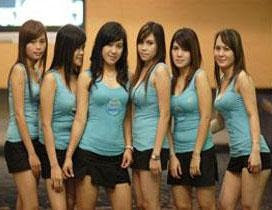 If added, batik would become Indonesia’s third entry, the others being the kris, a traditional dagger, and the wayang puppet theatre (nope, dangdut hasn’t made it onto the list yet).
If added, batik would become Indonesia’s third entry, the others being the kris, a traditional dagger, and the wayang puppet theatre (nope, dangdut hasn’t made it onto the list yet).
Personally I’m not a great fan of batik. The shirts are generally made of thickish material and not that comfortable to wear unless you are in an air-conditioned environment such as at an indoor wedding ceremony (which is when they are mostly worn of course).
Batik shirts are also a complete bitch to wash. Stick them in a washing machine with your white business shirts and say hello to a new bunch of light brown shirts in your shirt collection a short while later; the old white shirts mysteriously gone.
I’ve got a few batik shirts at home myself – just like every foreigner who has lived for a while in Indonesia I guess. They are the standard Jogya and Solo designs (sludgy brown and yellowy - Batik Keris I think) and, all credit to the tailors, they have served me extremely well and have not fallen apart at the seams despite years of use (maybe Indonesia’s telcoms firms could learn something from them about how to make a good quality product perhaps?)
It’s also interesting to note that batik is not supposed to show animal designs (including birds) due to that perennial problem of religious limitations and instead tends to show rather abstract designs, some apparently mystically influenced (which is quite ironic when you think about it).
Batik really made it on to the world stage a few year’s back thanks to that great black dude Nelson Mandela who championed the merits of the shirts over the standard Western business suit and tie.
And his efforts have been successful - in fact so successful that more than half of the men in the African country of Tanzania now wear batik on a daily basis – even prompting a bunch of Kenyan journalists visiting that country to conclude that batik shirts were the National Dress of Tanzania!
And batik also has great snob appeal – well at least the high quality hand made (batik tulis) stuff certainly does. These shirts are works of art in themselves and definitely not the sort of things to stick in the washing machine (or give to the maid to hand-wash lest she goes at the thing with a hard-bristled brush, reducing the precious article into rags after only five minutes.
For a good batik tulis shirt be prepared to fork out a few hundred bucks (Iwan Tirta does some nice ones), unless of course you are a famous foreign dignitary like Bill, and then you can probably get one for free.
 Hand made batik tulis shirts are really nice - but it can be a real bitch getting the stains out (just ask Monika)
Hand made batik tulis shirts are really nice - but it can be a real bitch getting the stains out (just ask Monika)
 If added
If added



Comments
Post a Comment